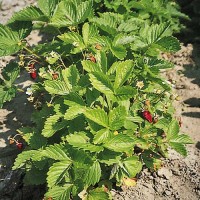
Growing Strawberries
Like apples, cherries, quinces and many other fruits, strawberries belong to the rose family (Rosacea). Typical for these family are the simple 5-petalled flowers. About 100 different varieties of strawberries are cultivated in Europe.
If the strawberry has the right location and is cared for well, the strawberry produces lots of bright red fruits and can be eaten in a wide variety of ways.
Location
Note: The bed to plant the strawberries in shouldn`t be freshly dug up. Also, to comply with crop rotation and not to leach the soil, no potatoes or strawberries should have been grown at the location in the previous 4 years.
Although strawberries can tolerate partial shade and slightly acidic soil, they will still produce more flowers and fruit in the sun.
If the plants are very sunny, they must be watered regularly.
The following guideline applies to the strawberry with regard to taste:
"The more sun - the more flavour!".
Soil
The optimal soil for strawberries has a pH value between 5.5 and 6 (slightly acidic - acidic). It should be loose and rich in humus, because compacted heavy soil can easily lead to damage of the strawberry roots.
Deep loosening / digging of the soil in combination with a submixture of leaf compost, horn grit or sand is a good idea to keep the plants healthy. Digging should be done about a week before planting and not immediately before.
Sowing
A pre-cultivation from February / March is recommended, from April the strawberries can then move into the open. Cover the seeds only minimally with soil. Prick out after germination, when the plantlets have formed their first true pair of leaves after the cotyledons.
For a higher germination rate, you can first expose the seeds to cold (for example, put them in the freezer for 2 - 3 weeks).
Spacing
The young strawberry plants should be planted outdoors with 60 cm row spacing and 30 - 35 cm planting distance. This leaves enough space for harvesting or spreading straw. Straw protects the soil from drying out and the fruits from rotting.
When planting, note that the plants should only be set deep enough to keep the heart of the plants off the soil surface.
Care
During dry periods, and when the plants are growing, they need a lot of water.
The soil needs to be cleared of weeds regularly. Spreading straw between the strawberries will both keep the moisture in the soil, keep the fruits clean and free of mould, and also slow down the growth of more weeds. After harvesting, the straw can be removed and the leaves as well as any undesirable young plants can be removed.
Fertilisation is always done after harvesting in autumn, because this is when the buds are laid out for next year`s harvest. The harvest is usually even smaller in the first year.
Important tips for care:
- Until the plants have grown properly, water daily to keep the soil moist.
- Cut off runners that stray too far from the main plant.
- Remove withered leaves and stems (clean out) regularly.
- Always check for growing weeds and remove them directly.
- Use organic fertiliser, preferably regularly (every 14 days).
- Spread a layer of straw under and between the strawberry plants.
Protection against pests and diseases
Good partners in mixed cultivation are: Borage, garlic, lettuce, leeks, radishes, onions or bush beans.
Strawberries are sensitive for pests like strawberry mite, strawberry blossom pest or soft skin mite.
Diseases such as Grey mould (Botrytis cinerea), red or black spot disease or root rot may occur.
The strawberry is already much stronger if the location and the soil are right. To get strong and healthy plants apply organic fertiliser and cover the soil with straw. If the planting distance is also correct, a lot has already been done for a healthy plant. Only in an extreme emergency you should use sprays to rid the strawberry of pests and diseases.
Harvest
Strawberries are ready for harvesting when their colour has reached a beautiful vibrant red. Harvest time is generally from May to the end of July.
Strawberries do not ripen any longer once they have been harvested. After harvesting, the fruits quickly lose vitamin C as their skin is thin, so it is best to consume them fresh.
If the harvest produces too much, it should be processed directly as jam or the remaining fruit frozen for later use (jam, compote, sauces, etc.).
Manufacturer
Name: | Chili-Food-Wissen |
Address: |














